I'm sharing some photos of wildflowers
that I have taken over the years,
mostly native flowers, here in
Eastern Quebec, the Gaspé region.
that I have taken over the years,
mostly native flowers, here in
Eastern Quebec, the Gaspé region.
Native flowers grow in the wild,
forest, beaches, ditches and fields,
forest, beaches, ditches and fields,
almost everywhere.
Most wildflowers are beautiful,
fragrant and colourful and can be used
for decorating, medicinal purposes and food
fragrant and colourful and can be used
for decorating, medicinal purposes and food
**************************
Asters
Aster Alpinus,
native to North America.
Member of the Asteraceae family.
Bees and butterflies are attracted to
this flower for Fall, late season nectar.
The flower, roots and leaves also provide
The flower, roots and leaves also provide
culinary and health benefits.
White Woodland Asters
Eurybia divaricata
Native to Eastern North America.
Flowers in the August in the woods and ditches.
Flowers in the August in the woods and ditches.
A favourite of bees and butterflies.

Beachgrass
Ammophilia Brevillgulara
Grows in sand and marine environments,
Grows in sand and marine environments,
spreading by subsurface runners, rhizomes
Their roots stabilizes coastal erosion.
Their roots stabilizes coastal erosion.

Creeping Bellflower, (Bluebell)
(Campanula rapunculoides)
(Campanula rapunculoides)
Used for medicinal purposes.
Extremely invasive.
Birds, bees and insects, feed on the nectar.
Birds, bees and insects, feed on the nectar.
A nuisance in flower beds.
I cannot get rid of them.
Buttercups
From the Ranunculaeace family.
They are beneficial in medical uses
in anti-rheumatism, intermittent fever
and some skin disorders.
Unfortunately these pretty bright
flowers are poisonous.
flowers are poisonous.
Beware too much handling can cause dermatitis.
Bird's Foot Trefoil
(Lotus Corniculatus)
(Lotus Corniculatus)
A member of the pea family Fabaceae.
An ornamental ground cover.
Fragrant flower in yellow or orange.
An ornamental ground cover.
Fragrant flower in yellow or orange.
I found these Bird's Foot Trefoil growing on the beach.
The also grow in the gravel on the roadside.
The also grow in the gravel on the roadside.
They grow low to the ground.
Used in agriculture as a forage plant,
grown for pasture, hay and silage.
Wild Caraway
(Carum Carvi)
(Carum Carvi)
From the Alaceae family.
A white group of flowers at the top of
several erect branched stems.
It develops a parsnip like root
with black skin and white core.
A white group of flowers at the top of
several erect branched stems.
It develops a parsnip like root
with black skin and white core.
Used for beauty and many culinary benefits.
Chicory (Cichorium intybus)
of the dandelion family Asteraceae.
Also known as blue daisy, blue dandelion,
wild bachelor's buttons and more.
Culinary uses in coffee, sweeteners, and stout beers.
Medicinal uses linked with insulin also.
Grows on the roadside and in ditches.
I found these growing beside railroad tracks.
So pretty on the roadside here in the Gaspé.

Clover
(Trifolium)
A member of the pea family Fabaceae
Usually have three leaves.
The four leaf clover are considered
a rarity and consider lucky.
a rarity and consider lucky.
Flower is usually pink or white
Clover is one of the main nectar sources for honeybees.
Clover is one of the main nectar sources for honeybees.
Shamrock, the Irish symbol is associated with clover.

Common Daisies
(Bellis Perennis)
(Bellis Perennis)
Member of the Asteraceae family.
Used in culinary and herbal medicine.
Medically used for homeopathy for
wounds and certain surgical procedures.
Medically used for homeopathy for
wounds and certain surgical procedures.
Common Daisies
He loves me ~ He loves me not,
We played this often in our younger yrs,
pulling out each petal,
hoping it will end at.....💖
"He loves me"

Dandelions
(Taraxacum)
(Taraxacum)
Member of the Asteraceae family.
The entire plant, including the leaves, stems,
The entire plant, including the leaves, stems,
flowers and roots is edible and nutritious.
Dandelions are found on 6 continents.
An early Spring source of food for wildlife,
bees, butterflies and moths.
Dandelions are found on 6 continents.
An early Spring source of food for wildlife,
bees, butterflies and moths.
Dandelion Seeds
Pick one. Close your eyes,
make a wish and blow the seeds into the air.
Only one wish granted.
make a wish and blow the seeds into the air.
Only one wish granted.
Dandelion Seedhead.
Pearly Everlasting
(Anaphalis margaritacea)
Member of the Asteraceae family.
Used by home herbalists as a tea,
medicinal uses and health benefits.
Drought tolerant, food source for butterflies.
Grow in ditches fields and wood edges.
Grow in ditches fields and wood edges.

Fireweed
(Chamaenerion Angustifoloum)
(Chamaenerion Angustifoloum)
Member of the Onagraceae family.
The floral emblem of the Yukon.
The floral emblem of the Yukon.
Usually grows in areas affected by forest fires.
Many health benefits such as tumors, enlarged prostate, etc.
Many health benefits such as tumors, enlarged prostate, etc.
From Bonaventure Island
looking towards Percé Rock, Gaspé.
Fireweed beyond the backyard.
Flowers in August.
An important plant for honey producers.
Attracts bees and hummingbirds.

Golden Marguerite.
(Cota Tinctoria)
(Cota Tinctoria)
Member of the Asteraceae family.
A yellow type daisy.
Also known as yellow Chamomile,
A yellow type daisy.
Also known as yellow Chamomile,
or Anthemis tinctorial.
Yellow orange dye from the flower,
used to colour fabric in the past.
Yellow orange dye from the flower,
used to colour fabric in the past.

Goldenrod
Solidago Vigaurea
Member of the Asteracese family.
Flowering in late Summer, August.
Flowering in late Summer, August.
Popular ingredient in herbal supplements and teas.
In the photo below, GoldenMarguerite and Goldenrod.)
Jewelweed
Impatiens Capensis
Small orchid-like flowers that grow in damp areas.
The juice of the leaves and stems, used for a
remedy for skin rashes, including poison ivy.
Very tiny.
(Eupatorium Dubium)
From the Daisy family (Asteraceae)
Plant grows wild in the woods,
entire plant is edible and
used for herbal teas.
Used in the 1800s to cure typhus.
Can grow up to 3 meters high.
Yellow Lady's Slipper.
(Cypripedium Parviflorum)
An wild orchid that grows in shady
An wild orchid that grows in shady
damp woodlands and attracts pollinators.
Lily Of The Valley
(Convallaria Majallis)
In the Asparaguecea family.
Lovely scented.
Leaves and buds and flowers are poisonous.
Used in perfumes, creams and bouquets,
and many medicinal purposes.
6-12in. tall, flowering in June in my region.

Visit a previous blog on more of
my connection with Lily Of The Valley.
Wild Musk ~ Mallow
(Malva Moschata)
(Malva Moschata)
From the Malvaceae family
Used for health, beauty and culinary benefits.
Grow in roadside ditches, also on the beach.
Grow in roadside ditches, also on the beach.
A fragrance flower, in pink and white.
Mallow
Easy to grow from their seeds
thrown in ditches, etc.
Narrowleaf
Blue-Eyed Grass
(Sisyrinchium Angustifolium)
These tiny flowers grow in the grass.
Member of the Iris family.
1/2 inch flower, yellow eyes.
If pollinated, flowers flowered by
a small dark seed capsule,
filled with tiny seeds.
I must observe and try to
get some seeds from the plant.
Wild Phlox.
(Phlox divaricata)
From the Polemoniaceae family.
A fragrant flower that attracts butterflies,
moths and hummingbirds.
Native to forests & fields in Eastern North America.
In a variety of colours from light purple, violet and white.
Another photo from the beach
Baie des Chaleur, Gaspé.
Princess Pine or Clubmoss
It's always a delight to spot this
fascinating plants in the forest.
A small ancient, slow growing plant
that grows in patches on the forest floor.
Grows to only 4 to 6 inches tall.
Prefers shady, moist woodland.
It has been over-harvested in the past,
used to make Christmas wreaths.

Queen Anne Lace ~ Wild Carrot.
(Daucus Carota)
(Daucus Carota)
From the Alaceae family
Grows on roadsides, in dry environments.
Grows on roadsides, in dry environments.
Flowers and roots are edible.
A dark purple spot appears in the middle
of some flowers of Queen Anne Lace.
Legend has it that the Queen pricked
her finger while making lace and left
a drop of blood in the middle.
 |
| Queen Anne Lace in a bouquet. |
Sedum ~ Stonecrop.
From the family Crassulaceae,
There are many types of sedum.
The one below appears in a ball shaped
plant in Spring with thick succulent leaves,
and turns a colourful red in the Fall.
The one below appears in a ball shaped
plant in Spring with thick succulent leaves,
and turns a colourful red in the Fall.

Sedum in Autumn.
Pretty red flowers
False Soloman's Seal
(Similacina Racemose)
(Similacina Racemose)
In the Asparaguecea family.
A relative of Lily Of The Valley.
An edible and medicinal plant used by Natives
for many uses, including rheumatism,
rash, coughs and headaches.
An edible and medicinal plant used by Natives
for many uses, including rheumatism,
rash, coughs and headaches.
The flowers turn to edible berries.
Enjoyed by beetles, small rodents
and other wild life.
Soloman's Seal
They turn a pretty red.

Tansy
Tanacetum Vulgare
Member of the Asteraceae family.
Used for medicinal,
culinary and health benefits.

Colourful in the month of August.
I have Tansy growing in my backyard.
The leaves can be dried and used in sachet bags.
I have also dried the flowers and used them in
flower decorations.
Tansy and the shoreline of the
Baie des Chaleur, in Fauvel.
It's scent is similar to
camphor with hints of rosemary.
It grows close to 6 ft. tall.
I don't know how true this is,
Tansy is a deterrent for bugs and rodents.

Thistle
From the Asteraceae family.
A picky plant, full of prickles,
that protects the plant from
being eaten by animals.
A plant with many beneficial qualities.
Floral resources for pollinators,
Seeds for small birds, goldfinches,
Foliage for butterfly larvae, and
Down for the lining of bird's nests.
The floral emblem of Scotland.
Toadflax, Butter and Eggs.
(Linaria Vulgaris)
(Linaria Vulgaris)
From the family Plantaginaceae
Similar to a snapdragon flower.
Has medicinal properties.
Food for a large number of insects,
Food for a large number of insects,
including as moths.
Blue Vetch
(Genus Vicia)
From the Fabaceae family.
Attracts bees and butterflies.
Vetch vine can grow up to 2 meters,
strangling out smaller plants.

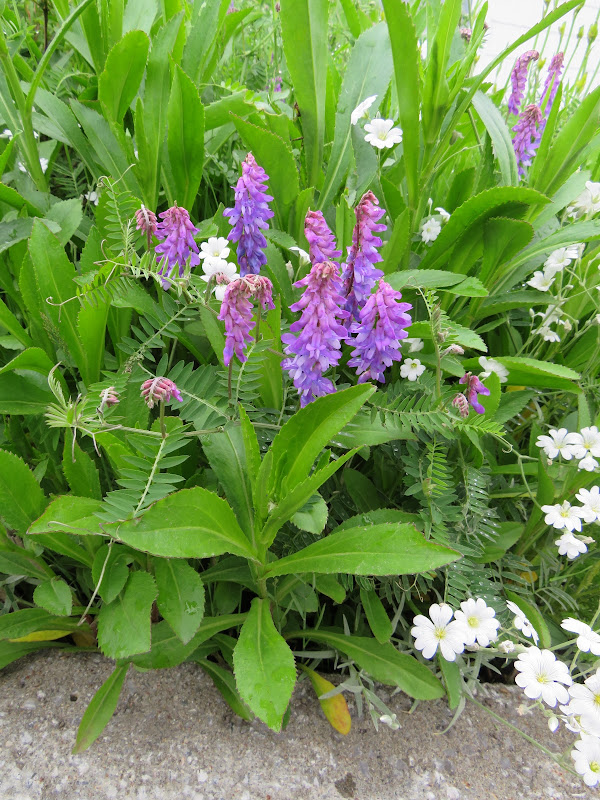
I find Vetch annoying in my flowerbed.

Wild Violets.
Grow in the forest.
From the Violaceae family.
Used in culinary, medicinal and
in the perfume industry.
Edible flower and leaves.
Their flowers of the Violet plant are short-lived
but the beautiful plants lasts all Summer.
In warmer regions they can be invasive,
a welcome site to see in the forests here.
White Wild Violets
Yarrow
(Asteraceae)
Grows in ditches, fields, on the beach and in forests.
Some birds use yarrow to line their nests.
Also food for many species of insects.
I'm surrounded by wildflowers.
They make beautiful bouquets.
Milkweed, goldenrod, Queen-Ann Lace, pink and
white musk, daisies, tansy, vetch and bluebells.
To view a previous blog on
Roses of the Gaspé,
click here.
Thanks for your visit.
💚💚💚















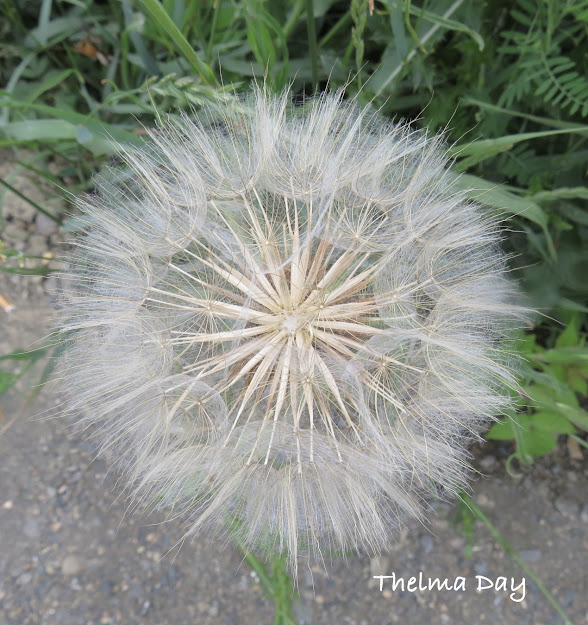



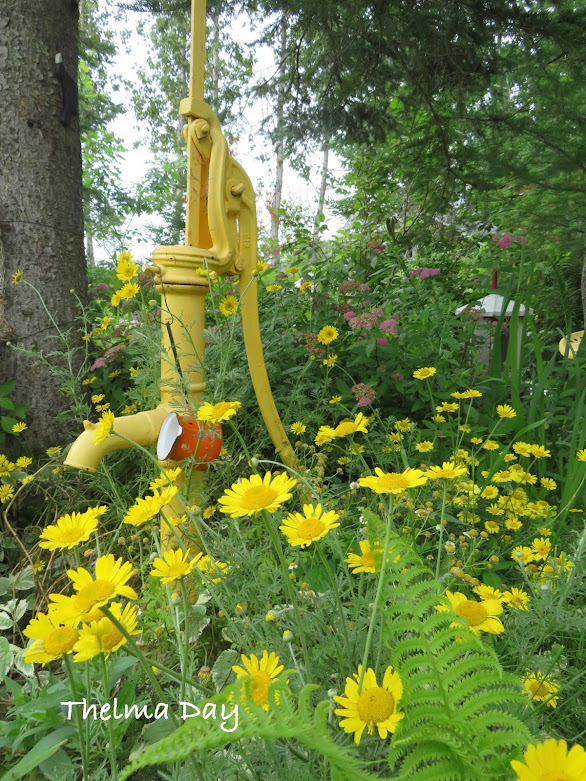


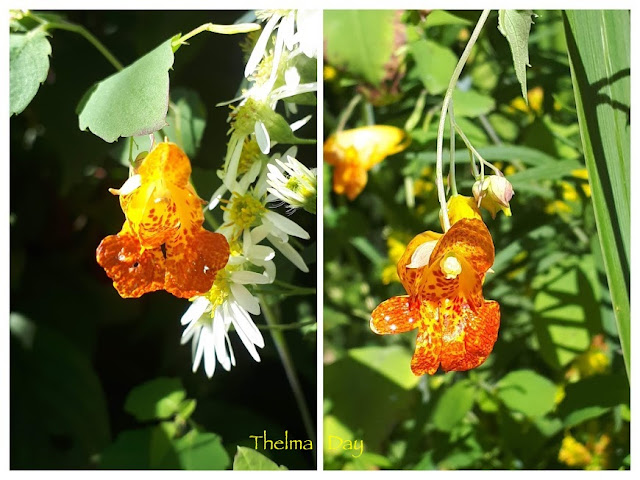










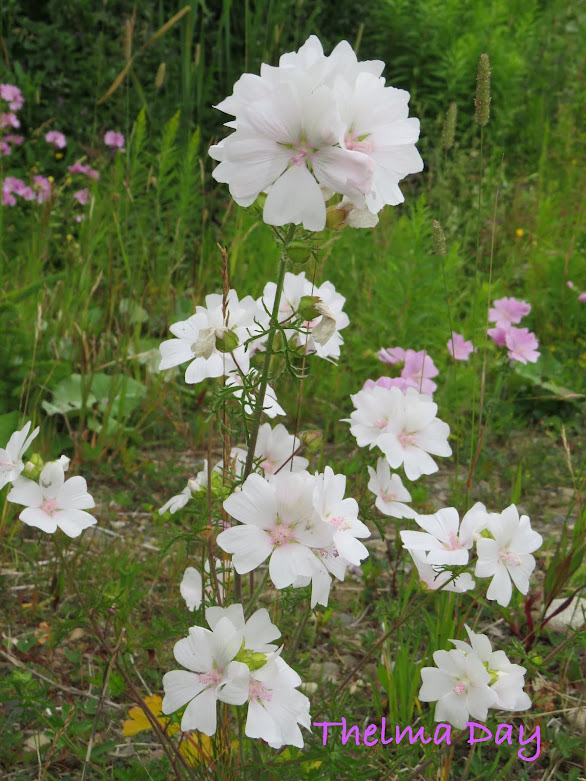



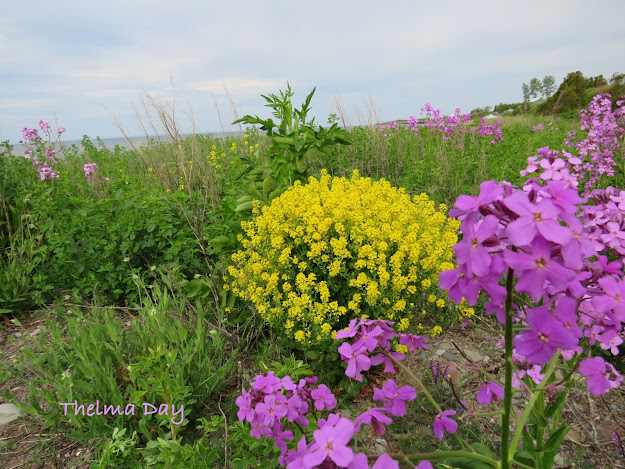














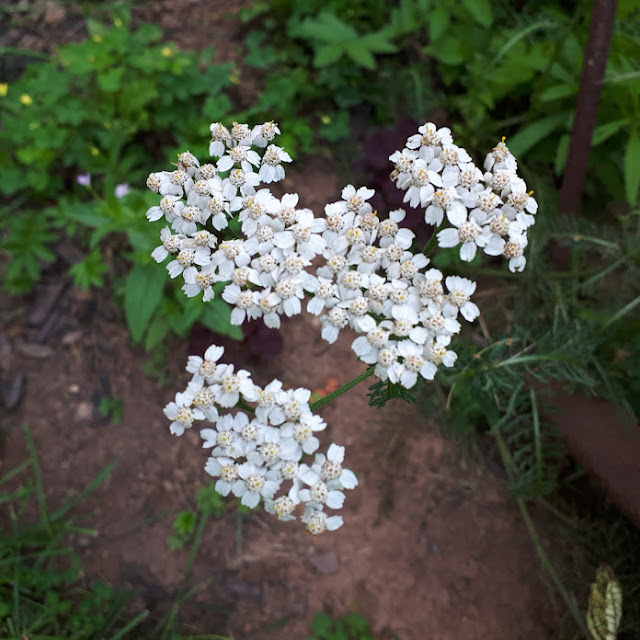


What a wonderful post---we don't have some of those, I haven't seen LadySlippers since I was a kid 60+ years ago. Again, simply lovely post! Thelma considering adding a link with a few of your photos then if someone pins one---it will lead back to the blog. I have found some new 'followers' that way. Also, I share each of my posts on my fb page---you can choose to share public or just with friends...and I get traffic that way, also.
ReplyDeleteThanks Sandi. Glad you enjoyed it. I do share on my FB page but to friends only. I'm also on Instagram at thel.day.
DeleteWhat a joy to visit your blog today and admire so much beauty. I have learnt so much from your post today, a real delight.
ReplyDeleteLovely post. The clover looks more like something from the onion family and I thought bellis perennis was much lower growing.
ReplyDeleteI wish we had some of those wildflowers here where I live.
There daisys usually grow from 2-3 ft. tall. Maybe you are referring to another kind. I'm fortunate to live in the country and surrounded by wildflowers.
DeleteWhat a wide range of beautiful wildflowers:-)))
ReplyDeleteThanks Nitka.
Deleteo My!! all of these flowers are just so lovely!! Thanks for sharing and thanks for stopping by!!
ReplyDeleteHugs,
Debbie
Thanks Debbie. Have a great Summer!
DeleteSo many pretty flowers! I’ve never seen lady slippers before. I can sure see why they got that name!
ReplyDeleteOh, I love wild flowers! Thanks for sharing with us at the Weekend Blog Hop at My Flagstaff Home! --Jennifer
ReplyDeleteYour wild flower garden is simply gorgeous ! I'm the type that loves even wild flower and simple arrangements, nothing fancy or professional looking. I feel as I'd love to be there.
ReplyDeleteThank you for your sweet and kind comment on my struggle about to continue blogging. You all helped made myself a decision, especially my husband. I posted a Summer table and explained my decision.
Big hugs,
Fabby
Thanks Fabby. I'm happy you will continue to blog. So many of my blogging friends have quit blogging. It's sad to see everyone leave. But that's life. Enjoy you Summer and I hope your Mom is feeling better soon. xo
DeleteWhat a lovely wildflower garden! I love wildflowers and take pictures of them often. Great post!
ReplyDeleteThanks Sylvia. We do have some beautiful flowers and it's nice to take notice and appreciate what beauty surrounds us.
DeleteSo many beautiful blooms! I have never seen yellow lady slippers; the ones around here are all pink.
ReplyDeleteThanks for your visit. Pink Lady's Slippers are pretty. Too bad I don't have them in this area.
DeleteCongratulations, Thelma! Your post will be featured this week at the Weekend Blog Hop at My Flagstaff Home! --Jennifer
ReplyDeleteThanks so much Jennifer. You made my day. I feel honoured to be amongst such talented bloggers. xo
DeleteLove all the flowers blooming in your garden beds, Thelma! I never knew wild cottonweeds name before but it blooms here in Texas in the springtime. Thank you for sharing at Share Your Style and of course I was happy to share your hayrake this week (#216!).
ReplyDeleteJust beautiful...
Hugs,
Barb :)
This comment has been removed by the author.
DeleteThanks Barb for featuring my hayraker xo
DeleteBeautiful flowers! Thank you so much for sharing on Farm Fresh Tuesdays!
ReplyDeleteI am using this blog for an ecology course where I am asked to identify wild flower. I have used your blog for many specimens already, but found that you have made a mistake. I believe you have Pearly everlasting instead of Wild Cottonweed. If you google the wild cottonseed, you are met with a plant that is much thicker and resembles pop corn. Your plant on the other hand is tall with thin long leaves and a silvery stem which would match the description of a Pearly everlasting. another useful link https://espacepourlavie.ca/en/biodome-flora/pearly-everlasting. Thank you for sharing your collection though, it was extremely useful and pretty.
ReplyDeleteThanks for your interest in my blog and for correcting me about he Wild Cottonweed.
ReplyDeleteI will make the change to my blog.
Good luck on your ecology course.